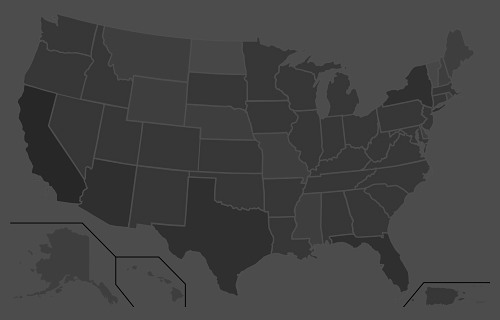“Our added winter moisture and active calling period led to a very long nesting and hatching season, starting in late April and extending into early summer, with chicks hatching as late as early July,” O’Dell said. “From a population standpoint, we are out of a deficit for the first time since 2001-2002. Quail are starting to pop up in places they haven’t been seen in a while.
“If you’ve never had the chance to experience what Arizona quail hunting built its name on, then this would be the year to get out and enjoy it.”
Meanwhile, hunters should note that the season for Mearns’ quail doesn’t begin until Dec. 4. It’s summer rainfall that plays a key role in nesting success and population numbers of this species. After a spotty and relatively weak monsoon across southern Arizona, these birds are likely to be abundant only in pockets that received sufficient precipitation this summer.
A valid Arizona hunting or combination hunt and fish license is required for all hunters 10 and older. Those hunters under 10 must either have a valid hunting or combination hunt and fish license, or be accompanied by an adult who possesses a valid hunting or combination hunt and fish license. Licenses can be purchased online or at license dealers statewide. A youth combination hunt and fish license (ages 10 to 17) is $5.
The general bag limit is 15 quail per day in the aggregate, of which no more than eight may be Mearns’ quail (when the Mearns’ season opens Dec. 4). The general possession limit is 45 quail in the aggregate after opening day, of which no more than 15 Gambel’s, scaled or California quail in the aggregate may be taken in any one day. After the opening of the Mearns’ season, the 45-quail possession limit may include 24 Mearns’ quail, of which no more than eight may be taken in any one day.
More quail-hunting information can be found on the department’s website at https://www.azgfd.com/Hunting/. Another resource for both new and experienced hunters alike is “An Introduction to Hunting Arizona’s Small Game.” Written by Randall D. Babb, the 196-page, full-color book covers where and how to hunt small game birds (like quail), squirrels, rabbits, ducks and geese. It also includes how to prepare and cook your harvest, with illustrations and recipes. The book can be ordered for $16.95 at www.azgfd.gov/publications.
Finally, hunters should check out O’Dell’s techniques for field-dressing quail at https://www.youtube.com/watch?v=3gRwZAcWzzk.
####
Publishers Notes: OUT OF STATE HUNTERS, FISHERMEN & OUTDOOR ENTHUSIASTS; Due to the Covid 19 pandemic, there could be limitations for OUT of STATE hunters, fishermen and other outdoor enthusiasts to include a 14-day quarantine requirement or negative COVID-19 testing alternative. Please check with the State's Department of Natural Resources BEFORE you travel or apply for the 2020 Fall Hunts.
Disclaimer: The views expressed on this site are that of the authors and not necessarily that of TBC Press
New Mexico GFD Purchases New Property in Southeast Area
Submitted by: TBC Press
Posted on: 10/04/21
The Backcountry Press
The country's premier daily HUNTING, FISHING & OUTDOOR news in the USA and around the globe. Read whats happening in your neck of the woods & beyond.
© 2020 TBC Press - All Rights Reserved Website Design by:
News # 14557
The New Mexico Department of Game and Fish (NMDGF) was joined by members of the State Game Commission, NGL Energy Partners LP, Energy, Minerals and Natural Resources Department Secretary Sarah Cottrell Propst and members of the public to cut the ribbon on a newly purchased property for the benefit of the lesser prairie chicken, other grassland birds, pronghorn and grassland habitats.
The acquisition of the Pipkin Ranch, located about 40 miles southeast of Fort Sumner was made possible through a public-private partnership with NGL Energy Partners and funds generated through the sale of fishing and hunting licenses. This 7,500 acre purchase connects two existing Department properties, creating over 10,000 continuous acres dedicated to New Mexico’s grassland wildlife.
“I’d like to thank the sportsmen and sportswomen of New Mexico and our NGL partners for their contributions to conservation,” said NMDGF Director Mike Sloane. “This public-private partnership is an example of the positive work that can occur when we all recognize the value of conservation. I am excited to have been a part of this effort and believe that it will stand as an example going forward as we begin to implement the 30 x 30 initiative recently advanced by the governor.”
Game Commission Chairwoman Sharon Salazar Hickey said, “Purchasing and maintaining property, such as this ranch, provide a great example of conserving wildlife habitat.” She added, “To the average eye, the Pipkin Ranch might look like rolling grassland with little value; but to the lesser prairie chicken it is a chance for growth – an important conservation stronghold!”
The lesser prairie chicken is an iconic American grouse species that is being considered for federal listing under the Endangered Species Act. The lesser prairie chicken tends to occupy native grasslands and prairies. One of the primary causes for concern for the lesser prairie chicken is loss of habitat.
NGL Energy Partners LP is a diversified, publicly traded, mid-stream energy company, with infrastructure to primarily move liquid hydrogen carbons and New Mexico water including waste water. NGL Energy Partners selflessly stepped in to facilitate the purchase – ensuring that this property, with its known multiple lesser prairie chicken leks, would be added to the state’s conservation portfolio.
Matthias Sayer, with NGL Energy Partners, said, “Given our land ownership and lease holdings in New Mexico, it was organic and natural that we engage with Game and Fish, and started talking about wildlife conservation not only on our properties and those we manage but across the State.”
This public-private partnership came about just days before Governor Michelle Lujan Grisham’s 30 x 30 initiative was issued. Sayer quoted from Governor Lujan Grisham’s executive order Protecting New Mexico’s Land, Watersheds, Wildlife and Natural Heritage, “Voluntary practices implemented by land managers, including private landowners and leaseholders, on working lands (both private and public) provide opportunities to support broader restoration activities, improve watershed health, create resilience in rural and urban communities, add value to the food chain and food security and contribute to the state’s outdoor recreation and eco-tourism economy.” Sayer continued, “That is exactly what has been done here today and we are happy to be a part of it.”
The full comments and ribbon cutting ceremony can be found on the Department’s YouTube Page.
####












